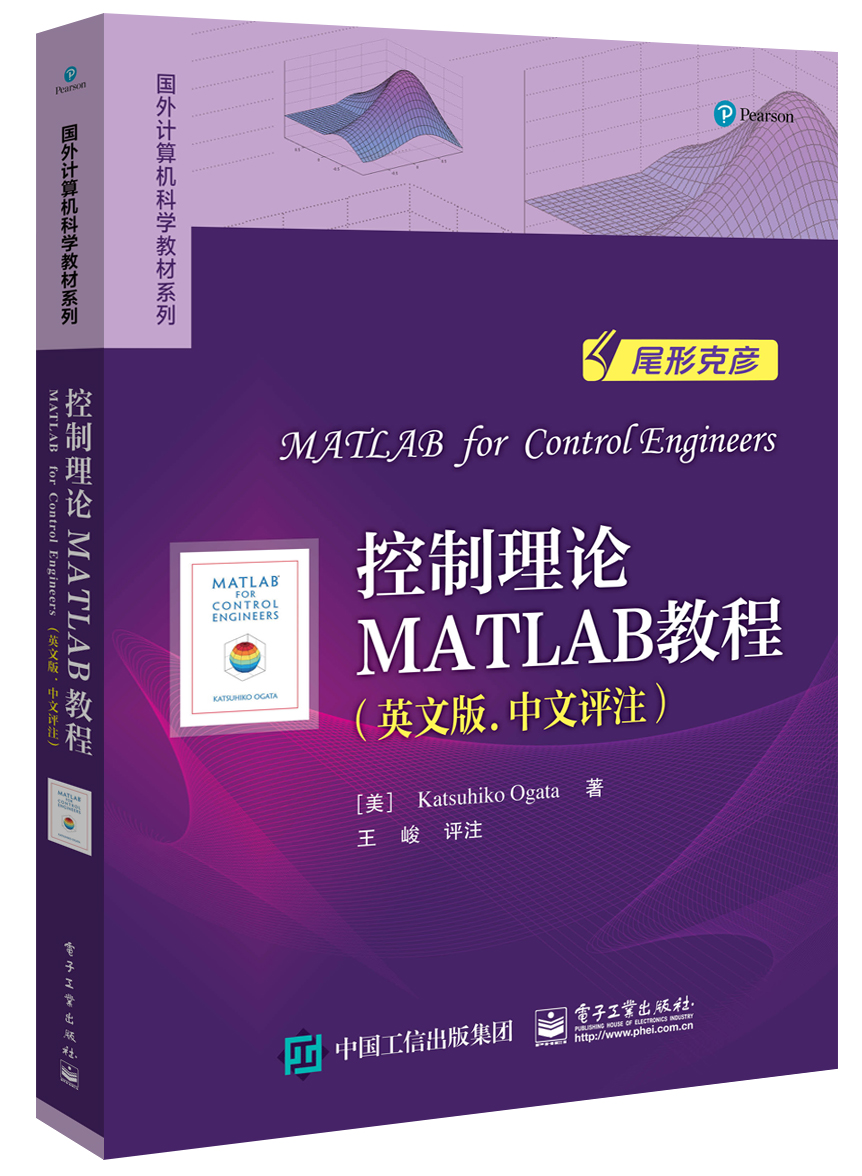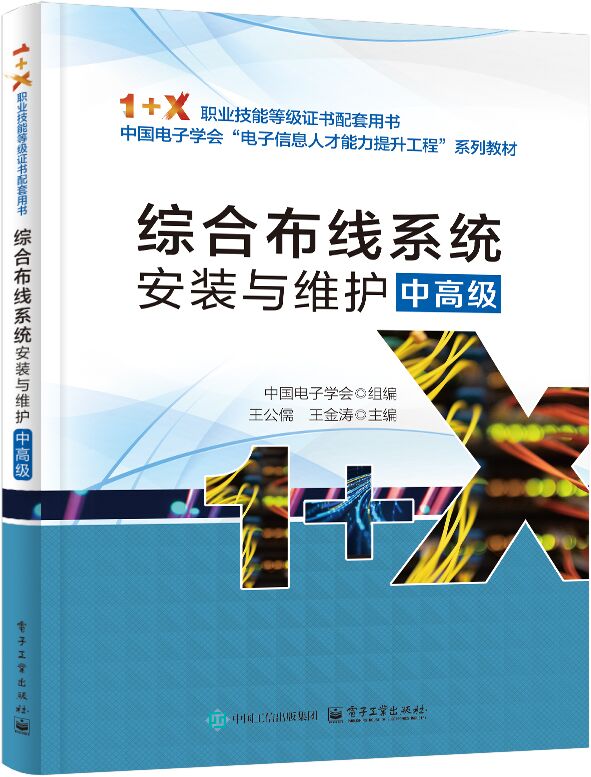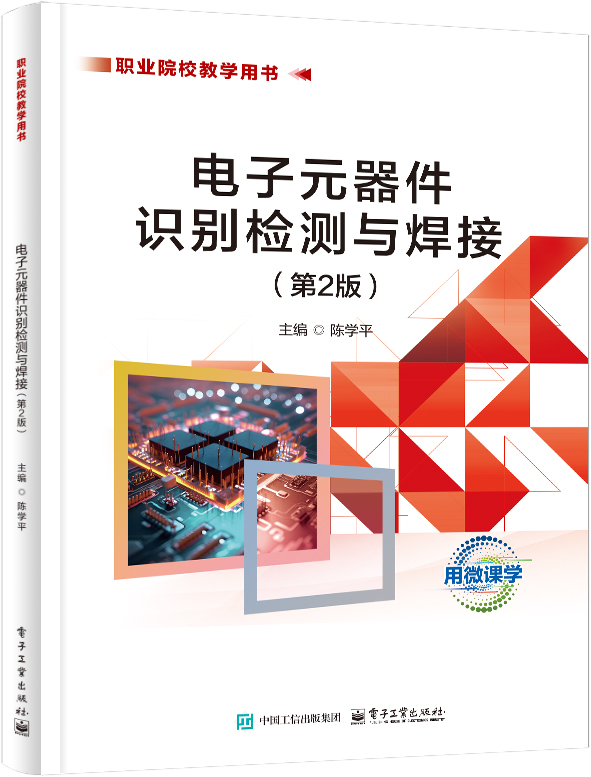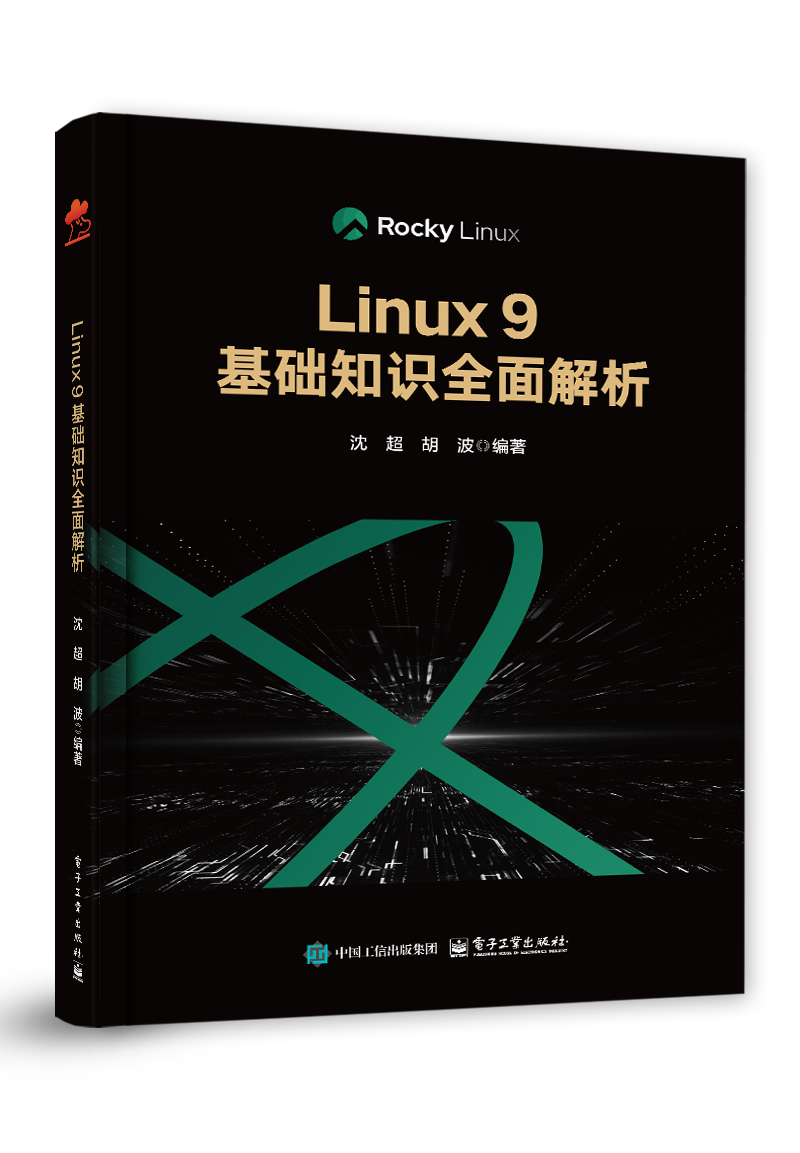控制理论MATLAB教程(英文版. 中文评注)
丛 书 名:
国外计算机科学教材系列
作 译 者:王峻
出 版 日 期:2019-09-01
书 代 号:G0373430
I S B N:9787121373435
图书简介:
本书系统讲述基于MATLAB的控制系统分析和设计方法。全书共7章。第1章总体介绍了MATLAB的基本命令;第2章介绍了MATLAB分析和设计控制系统的预备知识;第3章讨论了如何应用MATLAB获得动态系统的瞬态响应;第4章和第5章分别讲解了如何运用MATLAB进行根轨迹和频域方法的分析和设计;第6章讨论了如何通过MATLAB处理状态空间极点配置和观测器设计问题;第7章提供了控制系统设计中最优参数组的选取方法及二次型最优控制器的求解方法。
-
配 套 资 源
-
图 书 内 容
内容简介
本书系统讲述基于MATLAB的控制系统分析和设计方法。全书共7章。第1章总体介绍了MATLAB的基本命令;第2章介绍了MATLAB分析和设计控制系统的预备知识;第3章讨论了如何应用MATLAB获得动态系统的瞬态响应;第4章和第5章分别讲解了如何运用MATLAB进行根轨迹和频域方法的分析和设计;第6章讨论了如何通过MATLAB处理状态空间极点配置和观测器设计问题;第7章提供了控制系统设计中最优参数组的选取方法及二次型最优控制器的求解方法。图书详情
ISBN:9787121373435开 本:16开页 数:440字 数:1135.0本书目录
Chapter 1 Introduction to MATLAB MATLAB 简介 1–1 Introduction 引言 1–2 Addition, Subtraction, Multiplication, and Division with MATLAB 用MATLAB做加减乘除 1–3 Computing Matrix Functions 计算矩阵函数 1–4 Plotting Response Curves 绘制响应曲线 1–5 Three-Dimensional Plots 三维图形 1–6 Drawing Geometrical Figures with MATLAB 用MATLAB绘制几何图形 Chapter 2 Preliminary Study of MATLAB Analysis of Dynamic Systems 动态系统MATLAB分析的初步研究 2–1 Partial-Fraction Expansion with MATLAB 用MATLAB进行部分分式展开 2–2 Transformation of Mathematical Models of Dynamic Systems 动态系统数学模型的变换 2–3 MATLAB Representation of Systems in Block Diagram Form 框图形式的系统的MATLAB表达方式 Chapter 3 Transient-Response Analysis 瞬态响应分析 3–1 Introduction 引言 3–2 Step Response 阶跃响应 3–3 Impulse Response 冲激响应 3–4 Ramp Response 斜坡响应 3–5 Response to Arbitrary Input 对任意输入的响应 3–6 Response to Arbitrary Initial Condition 对任意初始条件的响应 3–7 Three-Dimensional Plots 三维图形 Chapter 4 Root-Locus Analysis 根轨迹分析 4–1 Introduction 引言 4–2 Root Locus Plots with Polar Grids 带有极坐标网格线的根轨迹图 4–3 Finding the Gain Value K at an Arbitrary Point on the Root Locus 求根轨迹上任意点的增益值K 4–4 Root-Locus Plots of Non–Minimum-Phase Systems 非最小相位系统的根轨迹图 4–5 Root-Locus Plots of Conditionally Stable Systems 条件稳定系统的根轨迹图 4–6 Root Loci for Systems with Transport Lag 具有传输时延的系统的根轨迹 4–7 Root-Locus Approach to Control Systems Compensation 控制系统校正的根轨迹方法 Chapter 5 Frequency-Response Analysis 频率响应分析 5–1 Plotting Bode Diagrams with MATLAB 用MATLAB绘制伯德图 5–2 Plotting Nyquist Diagrams with MATLAB 用MATLAB绘制奈奎斯特图 5–3 Log-Magnitude-Versus-Phase Plots 对数幅相特性图 5–4 Phase Margin and Gain Margin 相角裕度和增益裕度 5–5 Frequency-Response Approach to Control Systems Compensation 控制系统校正的频率响应方法 Chapter 6 MATLAB Approach to the State-Space Design of Control Systems 控制系统状态空间设计的MATLAB方法 6–1 Introduction 引言 6–2 Controllability and Observability 可控性和可观性 6–3 Pole Placement 极点配置 6–4 Solving Pole-Placement Problems with MATLAB 用MATLAB解决极点配置问题 6–5 Design of State Observers with MATLAB 用MATLAB设计状态观测器 6–6 Minimum-Order Observers 最小阶观测器 6–7 Observer Controllers 观测器控制器 Chapter 7 Some Optimization Problems Solved with MATLAB 用MATLAB求解优化问题 7–1 Computational Approach to Obtaining Optimal Sets of Parameter Values 获得最优参数集的计算方法 7–2 Solving Quadratic Optimal Control Problems with MATLAB 用MATLAB求解二次型最优控制问题 Appendix A 附录A References 参考文献 Index 索引展开前 言
导??读 MATLAB语言已成为控制领域最流行的仿真语言之一,也是该领域最流行的控制系统分析与设计的计算机辅助工具。目前,MATLAB已被融入控制理论的教学,有些学校甚至专门开设了关于MATLAB应用的课程。本书既可作为控制系统仿真课程的教材,也可作为本科生或研究生自动控制原理课程的辅助教材。本书深入浅出的写作风格也使它适合作为从事控制领域工作的科研人员和工程技术人员的自学用书和参考手册。 控制类专业的读者在初次接触MATLAB时,通过两种方法都能学会使用MATLAB。一种方法是,基本按照MathWorks公司提供的MATLAB使用手册,特别是控制系统工具箱手册中的内容,全面地、分门别类地学习MATLAB命令。在经过较长时间的练习之后,读者会比较全面地掌握MATLAB的知识。但是,在按照MATLAB手册的体系进行学习的过程中,读者往往会感觉内容繁杂并且体系庞大。另一种方法是,在简单了解MATLAB的基本概念之后,按照控制理论中需要解决的问题来学习和使用有关的命令。由于马上就能解决迫切需要解决的问题,读者立即会对要学的内容产生极大的兴趣。经过较短时间的练习,读者就会熟悉相当数量的关键命令;举一反三,也就能很快地掌握采用MATLAB解决控制理论问题的能力。这本教材采用的正是后一种方法。 MATLAB教材比比皆是,而介绍如何运用MATLAB软件解决控制问题的书籍却不多见。由于MATLAB已经成为一个庞大的仿真软件,所以让读者在有限的时间内掌握这种软件,并运用其分析、理解和解决控制理论问题,一直是控制专业类师生及应用人员的迫切愿望。所幸的是,本书将MATLAB的介绍和控制理论的学习有机地融合在一起,对需要掌握的MATLAB内容及其深度也把握得恰到好处。读者很容易通过本书来运用MATLAB解决控制问题,而不会被“淹没”到软件的庞大体系之中。 Ogata教授撰写的Modern Control Engineering一书已成为控制理论的经典教材之一,本书的编排与这本教材是同步的。读者一打开本书就会有一种似曾相识的亲切感,也许就会有继续研读的愿望。书中除了开篇关于MATLAB基本内容的介绍,其他章节的安排基本上与Modern Control Engineering一一对应,覆盖了系统建模、瞬态响应分析、根轨迹分析、频率响应分析,以及状态空间控制系统设计方法和优化问题。因此,本书基本上按照控制理论的体系来安排全书内容,体现了控制理论为主体,MATLAB为辅助工具的思想。这种编排方式便于学生同步学习或针对特定控制问题寻求MATLAB处理方法。 本书的主要目的是讲述如何使用MATLAB命令来分析和解决控制问题,但书中也比较全面地介绍了控制理论的基本概念和理论,并以MATLAB命令对例题进行了全面的分析和求解,所以读者会感到书中的内容特别具有针对性。因此,通过对本书的学习不仅能够掌握利用MATLAB进行控制系统仿真的技能,而且能够加深对控制理论中基本概念的理解,培养控制系统分析和设计的能力。 本书原著的英文影印版和翻译版在电子工业出版社分别出版过,深受广大读者青睐。鉴于国内许多高校都开设了英语授课或中英双语授课的课程,需要有适合的教材,而学生或工程技术人员在阅读英文时可能因为语言障碍而影响对知识点的理解和掌握,我们应读者要求推出了本书的评注版。该版本既保留了英文原著的内容,又针对关键知识点进行了中文注释和点评。正是由于本书的许多特点,相信很多读者都会开卷有益。对于本书评注的错误和不妥之处,也敬请广大读者批评指正。 十年前,我有幸和王诗宓教授在清华大学共同讲授“自动控制原理”英文课。更为庆幸的是,我有机会和他共同翻译出版了本书中译本,而此次评注内容在该版本基础上修改、润色而成,因此本书的出版也离不开王诗宓先生的贡献。谨以此书献给先生! 王?峻 同济大学 Preface This book is written to assist those students and practicing engineers who wish to study MATLAB to solve control engineering problems. It is written at the level of the senior engineering student. The book is organized into seven chapters. Chapter 1 presents an introduction to MATLAB.Chapter 2 deals with preliminary materials that the reader must know prior to applying MATLAB to the analysis and design of control systems. Chapter 3 is a detailed discussion of how to apply MATLAB to obtain transient response outputs of dynamic systems to time-domain inputs. Chapter 4 treats root-locus analysis and design with MATLAB. Detailed frequency-response analysis and design with MATLAB are given in Chapter 5. Chapter 6 discusses state-space design problems, such as pole placement and state observers, solved with MATLAB. Finally, Chapter 7 presents a computational approach to obtaining optimal sets of parameter values in connection with control systems design. The book concludes with a discussion of MATLAB’s approach to solving quadratic optimal control problems. The book includes some of the MATLAB materials presented in my previous publications Modern Control Engineering (4th ed.) and System Dynamics (4th ed.). All sample problems discussed in the book are given detailed explanations so that the readers will acquire a good understanding of MATLAB’s approach to solving the analysis and design problems presented. The book assumes that the reader has a relatively new version of MATLAB in his or her computer. In plotting root-locus diagrams or Nyquist diagrams with MATLAB, the reader’s grid command may produce grid lines or curves different from those presented here; it all depends on the version of MATLAB. (For problems that may arise with regard to grid lines or curves, see the appendix.) It is hoped that the readers will find this book useful in applying MATLAB to solve many control engineering problems. KATSUHIKO OGATA展开作者简介
本书暂无作者简介 -
样 章 试 读
-
图 书 评 价 我要评论









